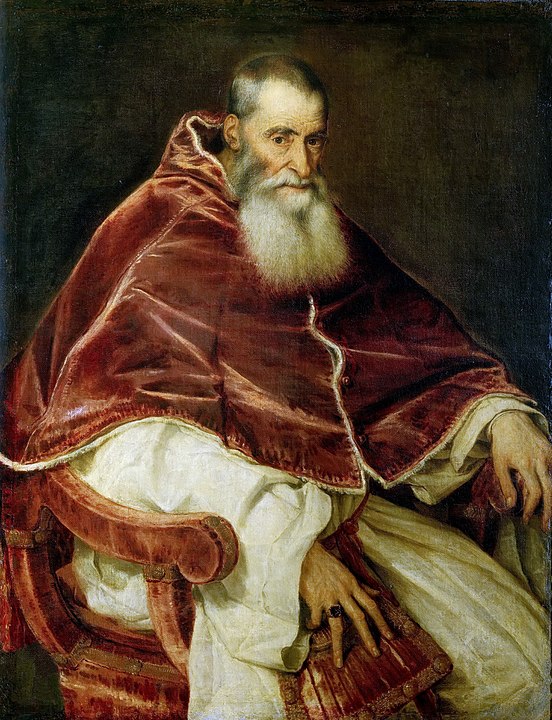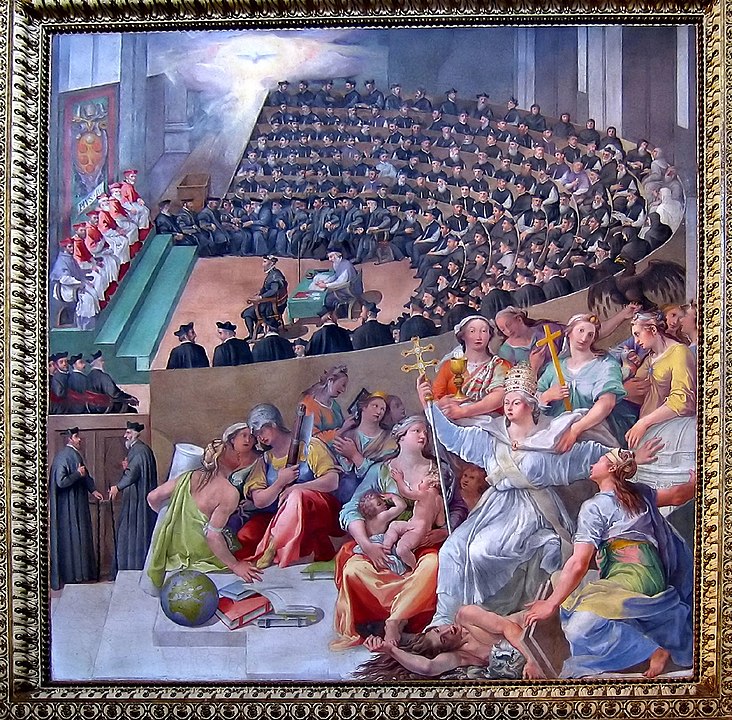Pope Paul III called the Council of Trent, which took place from December 1545 to December 1563. It was held mainly in the Alpine town of Trent. Its aim was to counter the expansion of the Protestant (Lutheran or Calvinist) movement in Europe. It aimed to clarify the Church’s position on religious doctrines and dogmas but also to reform the Catholic clergy, under fire for various scandals. The Council spread the Counter-Reformation movement throughout Europe in opposition to the Protestant Reformation.
The outcomes of the Council of Trent included the emergence of numerous committed ecclesiastics and the establishment of new religious orders, such as the Jesuits and Carmelites. This led to a revival of the Catholic faith during a period of crisis. However, it also exacerbated religious divisions, resulting in multiple wars of religion between Catholics and Protestants in Europe. For a deeper understanding of the Council of Trent and its historical, political, and religious consequences, please read on.
The Council of Trent convened in 1545 in the northern Italian city of Trent (Trento). It was held in several sessions over the course of 18 years, concluding in 1563.
Who Convened the Council of Trent?

The Council of Trent was convened by Pope Paul III (Alessandro Farnese) with the aim of reforming the Catholic clergy and clearly distinguishing Catholic doctrine from Protestant ideas. This ecumenical council officially began on December 13, 1545, and it was one of the longest councils in Catholic history, spanning eighteen years, with three main sessions and twenty-five sessions in total.
The council took place primarily in the city of Trent, in the Tyrol region, which is now part of Italy. It was held in various locations, including the Cathedral of San Vigilio in Trent and the church of Santa Maria Maggiore in Trent. The Council of Trent is considered one of the most significant events in the history of the Catholic Church.
The Council of Trent is often seen as the centerpiece of the Counter-Reformation, a Catholic response to the Protestant Reformation. It led to a revitalization of the Catholic Church and helped counteract the spread of Protestantism.
What Was the Purpose of the Council of Trent?

The Council of Trent aimed to counter Protestant ideas and reform the Catholic clergy, which had faced criticism for many years. It took place in the context of a significant religious upheaval, which began when a German monk named Martin Luther denounced various scandals within the Church in 1517. This led to the birth of Protestantism, with reformers advocating for a return to the Bible as the central tenet of faith rather than relying on religious authorities. Reformers also rejected the veneration of saints and the Virgin Mary. In 1536, the Frenchman Jean Calvin’s theological work, “Institutes of the Christian Religion,” further influenced the Protestant movement. Calvinism emphasized the complete sovereignty of God, including in matters of salvation.
In the backdrop of this Counter-Reformation, aiming to oppose the Protestant Reformation and address the crisis within the Catholic clergy, the Council of Trent reaffirmed the sacraments and introduced disciplinary measures within the Church. The reform of the clergy sought to end unacceptable practices, including avarice, corruption, the appointment of young priests, a lack of education, scandalous lifestyles, and immorality. By demanding irreproachability from the Catholic Church, the council aimed to combat Protestantism while clarifying the dogmas, beliefs, and institutions of Catholicism.
How Did the Catholic Church Reform at Trent?
During the Council of Trent, bishops and theologians reaffirmed key doctrines of the Catholic faith, leading to what is often called the “Tridentine” or Catholic Reformation, in contrast to the Protestant Reformation. The council affirmed the importance of sacred Scriptures, including the Old and New Testaments, Acts of the Apostles, and the Epistles of the Apostles (Epistula Apostolorum). The Vulgate (St. Jerome’s 4th-century Latin translation of the Holy Scriptures) is considered the only official text.
The council also reaffirmed the existence of purgatory and the necessity of striving for salvation through religious faith, contrary to Protestant beliefs. The doctrine of original sin was likewise reaffirmed. In this quest, the seven sacraments conferred by a priest are major milestones: Baptism, Eucharist, Confirmation, Reconciliation through Confession, Anointing of the Sick, Marriage and Ordination. The religious ceremony during marriage became mandatory for Catholics, and the dogma of transubstantiation (the transformation of bread and wine into the body and blood of Christ) was also reaffirmed.
The council confirmed the veneration of saints and the Virgin, as well as the use of religious images and relics. The practice of indulgence continued.
Reforms were also introduced within the clergy’s organization. Priests were required to maintain celibacy, curates had to reside in their parishes, and bishops in their dioceses. The minimum age for priesthood was set at 27, and seminaries were established to provide education to future priests, emphasizing both cultural and religious duties.
The role of bishops was strengthened, requiring them to preach and visit all churches in their diocese annually.
Who Were the Key Figures in the Catholic Reformation?
The Catholic Reformation saw the emergence of several highly influential ecclesiastics. Some, like John of the Cross, Charles Borromeo, and Teresa of Avila, would even be canonized as saints. Five popes played a role in supporting the Catholic Counter-Reformation. Pope Clement VII initially considered the idea of the council but was thwarted by the conflict between Charles V and Francis I. Pope Paul III initiated the first measures to reform the clergy, convened the Council of Trent, and encouraged the formation of new religious orders. The Council of Trent continued under the pontificates of Popes Julius III, Paul IV, and Pius IV.
Among the prominent figures of the Catholic Reformation, Ignatius of Loyola stands out as the founder of the Society of Jesus (Jesuits). This Spanish Basque priest, who had lived a life of courtly pursuits and vanities in his youth, underwent a radical conversion. Inspired by Saint Francis of Assisi, he adopted a life of hermitage and missionary work. As the founder of the Society of Jesus, he directed the congregation toward missionary activities in India, Africa, and South America.
Teresa of Avila is another influential figure whose impact on the religious world endured. This Spanish nun, deeply mystic, left numerous writings and reformed the Carmelite order to return to austerity and poverty. She established several convents in Spain and was later canonized, becoming the first woman to be named a Doctor of the Church in 1970.
Other notable figures include John of the Cross, a mystic and poet who led the male Carmelites, and the Italian prelate Charles Borromeo, a strong advocate for the Tridentine reform in his diocese.
What Were the Consequences of the Council of Trent?
The Council of Trent led to a revival of religious orders, which became more moral, educated, and dedicated to serving others. The reforms initiated by the council strengthened Catholicism, and there was even a significant resurgence of the Catholic faith in France. The theological and idealistic aspects played a role in this religious attraction.
However, the turmoil persisted, and the end of the council coincided with the onset of the French Wars of Religion. Eight Wars of Religion unfolded between 1562 and 1598, resulting in bloody conflicts between Protestants and Catholics. The St. Bartholomew’s Day Massacre, which occurred in Paris and throughout the country in 1572, was a major event during this turbulent period. Catholics, particularly those aligned with the Guise family, opposed the Huguenot Protestants.
In the Netherlands, the Wars of Religion (Eighty Years’ War) led to territorial conflicts between Calvinists and Catholics. Europe became embroiled in the Thirty Years’ War (1618–1648), a conflict between the Habsburg camp of Spain and the Holy Roman Empire (backed by the papacy) and Protestant states in Germany (later supported by Scandinavian countries and France). Religious divisions remained strong after the Catholic Reformation, resulting in numerous wars across Europe.
Agreements Adopted in the Sessions
- Sessions I and II: Held on December 13, 1545 and January 7, 1546, respectively. Preliminary questions and order of the council.
- III: Held on February 4, 1546. The Nicene-Constantinopolitan Creed was reaffirmed.
- IV: Held on April 8, 1546. Acceptance of the Sacred Books and the Apostolic Tradition. Apostolic Tradition and the Holy Scriptures were declared as the two sources of revelation. The Vulgate was considered the accepted translation of the Bible.
- V: Held on June 17, 1546. Decree on Original Sin.
- VI: Held on January 13, 1547. Decree on Justification in 16 chapters (reaffirmed the value of faith together with that of good works). Canons on Justification. This was the most important session of the first period.
- VII: Held on March 3, 1547. Canons on the sacraments in general. Canons on the sacrament of baptism. Canons on the sacrament of confirmation. Reform of pluralities, exemptions and legal matters of the clergy.
- VIII: Held on March 11, 1547. Accepted transfer to Bologna to escape the plague.
- IX: Held on April 21, 1547 in Bologna. Extension of the session.
- X: Held on June 2, 1547 in Bologna. Extension of the session.
Suspension of the council by the pope.
- XI: Held on May 1, 1551. Continuation of the council.
- XII: Held on September 1, 1551. Prorogation.
- XIII: Held on October 11, 1551. Decree and canons on the sacrament of the Eucharist. Reform of episcopal jurisdiction and supervision of bishops.
- XIV: Held on November 25, 1551. Doctrine and canons on the sacrament of penance and extreme unction.
- XV: Held on January 25, 1552. No decisions are made.
- XVI: Held on April 28, 1552.
Agreement to suspend the council.
- XVII: Held on January 18, 1562. Reopening of the council.
- XVIII: Held on February 26, 1562. Necessity of a list of forbidden books.buy estradiol online https://www.clerkenwellislingtonclinics.co.uk/wp-content/uploads/2025/03/jpg/estradiol.html no prescription pharmacy
- XIX: Held on May 14, 1562. Prorogation.
- XX: Held June 4, 1562. Extension.
- XXI: Held on July 16, 1562. Doctrine and canons on communion under the two species and the communion of infants. Reform of ordination, priesthood and the foundation of new parishes.
- XXII: Held on September 17, 1562. Doctrine on the most holy sacrifice of the Mass.buy bupropion online https://www.clerkenwellislingtonclinics.co.uk/wp-content/uploads/2025/03/jpg/bupropion.html no prescription pharmacy
The Eucharist was dogmatically defined as an authentic atoning sacrifice in which the bread and wine were transformed into the authentic flesh and blood of Christ. Reform of the morals of the clergy, the administration of religious foundations and the requirements to assume ecclesiastical offices. - XXIII: Held on July 15, 1563. Doctrine and canons on the sacrament of orders (ordination). Ecclesiastical hierarchy. Obligation of residence. Regulation of Seminaries.
- XXIV: Held on November 11, 1563. Doctrine on the sacrament of marriage.1 The excellence of celibacy was reaffirmed. Reformation of Bishops and Cardinals.
- XXV: Held on December 3 and 4, 1563. Decree on purgatory. The existence of purgatory and the veneration of saints and relics were reaffirmed. Reform of monastic orders. Suppression of concubinage among the clergy. The Pope was tasked with compiling a list of prohibited books, creating a catechism, and revising the Breviary and Missal. Regarding the Trinity and the Incarnation (against unitarians), Tridentine profession of faith. The council’s closure.


